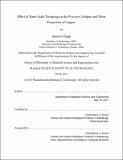Effect of nano-scale twinning on the fracture, fatigue and wear properties of copper
Author(s)
Singh, Aparna, Ph.D. Massachusetts Institute of Technology
DownloadFull printable version (5.865Mb)
Alternative title
Fracture, fatigue and wear properties of nano-twinning copper
Other Contributors
Massachusetts Institute of Technology. Dept. of Materials Science and Engineering.
Advisor
Christopher A. Schuh.
Terms of use
Metadata
Show full item recordAbstract
Grain refinement in materials has been one of the most common strategies for improving the strength of materials. However this comes at the price of reduced ductility, fracture toughness and stable fatigue crack propagation life. It has been shown that controlled introduction of nano scale growth twins in ultra fined grained (UFG) Cu through pulsed electro deposition leads to an increase in strength while maintaining a significant amount of ductility. Besides, introduction of deformation twins by the process of dynamic plastic deformation (DPD) involving repeated compaction of coarse-grained (CG) copper at high strain rates and cryogenic temperatures have also shown similar trends in terms of improved strength and considerable strain before failure. Unlike grain boundaries, twin boundaries do not adversely affect the electrical conductivity and resistance towards electro migration of copper. However there have been no studies done to elucidate the role of nano-scale twins in affecting the fracture toughness, stable crack propagation and response under contact fatigue. The aim of the current work was to gain an understanding of the role of microstructural length scale and design in terms of the introduction of twin boundaries vs. grain refinement in influencing the above-mentioned properties. With this aim stable crack propagation and fracture toughness studies were done on UFG copper specimens produced by pulsed electro deposition with an average grain size of 400-500nm but different twin densities to elucidate the effect of twin density on the damage tolerance of Cu. It was found that unlike grain refinement, twin lamellae refinement leads to an improvement in fracture toughness and stable fatigue crack growth life. In order to characterize the contact fatigue response of nano twinned copper, frictional sliding experiments were performed with a conical diamond indenter. The effects of twin density and number of repetitions of sliding cycles on the evolution of frictional coefficient and material pile up around the diamond indenter were studied quantitatively using depth-sensing instrumented sliding indentation. Cross-sectional focused ion beam (FIB) and scanning electron microscopy (SEM) observations were used to systematically monitor deformation-induced structural changes as a function of the number of frictional sliding passes. Nano indentation tests on the sliding tracks coupled with large-deformation finite element modeling (FEM) simulations were used to assess local gradients in mechanical properties and deformation around the indenter track. The results indicate that friction evolution as well as local mechanical response is more strongly influenced by local structure evolution during repeated sliding than by the initial microstructure. The frictional sliding experiments also lead to the striking result that Cu specimens with both high and low density of nano twins eventually converge to a similar microstructure underneath the indenter after repeated tribological deformation. Similar trend of convergence of microstructure and hardness in the vicinity of the scratch was also observed for DPD and CG Cu. This trend strongly mirrors the well-known steady-state response of microcrystalline copper to cyclic loading. General perspectives on contact fatigue response of nano-twinned copper are developed on the basis of these new findings.
Description
Thesis (Ph. D.)--Massachusetts Institute of Technology, Dept. of Materials Science and Engineering, 2011. This electronic version was submitted by the student author. The certified thesis is available in the Institute Archives and Special Collections. Cataloged from PDF version of thesis. Includes bibliographical references (p. 143-154).
Date issued
2011Department
Massachusetts Institute of Technology. Department of Materials Science and EngineeringPublisher
Massachusetts Institute of Technology
Keywords
Materials Science and Engineering.